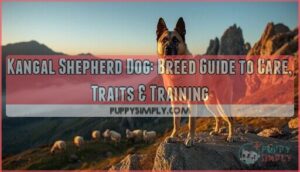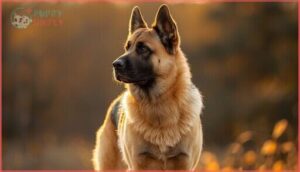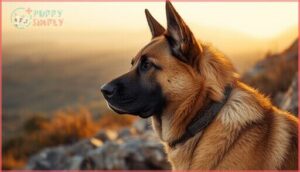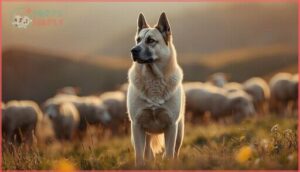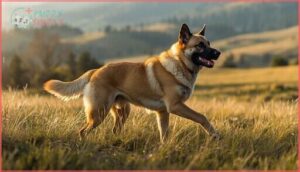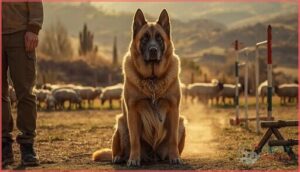This site is supported by our readers. We may earn a commission, at no cost to you, if you purchase through links.
The Kangal Shepherd Dog stands as one of the world’s most formidable livestock guardians, bred for over 800 years in Turkey’s rugged Sivas region to protect flocks from wolves and bears.
This ancient breed combines immense physical power—males can reach 145 pounds—with a temperament that surprises many first-time owners: calm, measured, and remarkably gentle with their families. Unlike many large guardian breeds, Kangals don’t react with blind aggression but assess each situation with what breeders call “selective aggression,” responding only when genuine threats emerge.
Understanding this breed’s unique balance of protection and restraint becomes essential if you’re considering adding one to your home, as their needs differ markedly from typical family dogs.
Table Of Contents
- Key Takeaways
- Kangal Shepherd Dog Origins and History
- Physical Characteristics of Kangal Shepherd Dogs
- Temperament and Personality Traits
- Exercise and Activity Needs
- Training and Socialization Essentials
- Health and Lifespan of Kangals
- Grooming, Diet, and General Care
- Frequently Asked Questions (FAQs)
- Conclusion
Key Takeaways
- Kangal Shepherd Dogs are ancient Turkish livestock guardians combining immense physical power (males reach 145 pounds) with selective aggression—they assess threats carefully before responding rather than reacting impulsively.
- These dogs require extensive early socialization between 3-14 weeks to prevent fear-based reactions and aggression, as unsocialized Kangals face 4.5 times higher anxiety rates and significantly reduced recall reliability.
- Despite their size, Kangals need moderate endurance-focused exercise (1.5-2 hours daily) rather than intense activity, and they’re unsuitable for apartment living due to their need for outdoor space to patrol and fulfill guardian instincts.
- With proper care and proactive health management, Kangals typically live 12-15 years—impressive longevity for large breeds—though they’re prone to hip dysplasia (19%), bloat (8-11% lifetime risk), and eye conditions like entropion (13-17%).
Kangal Shepherd Dog Origins and History
The Kangal Shepherd Dog isn’t just another large breed—it’s a living piece of Turkish history with roots that stretch back centuries. Understanding where these dogs come from helps you appreciate why they act the way they do and what makes them such effective guardians.
Let’s look at the key moments that shaped this noteworthy breed into what it’s today.
Turkish Roots and Heritage
The Kangal Shepherd Dog traces its Anatolian origins to the Sivas region of Turkey, where it’s served as a National Symbol for over 800 years. This Turkish Kangal emerged from pastoral traditions on the high plateau, earning Heritage Status as Turkey’s protected breed.
You’ll find it woven into Turkish culture—featured on stamps and celebrated as a national treasure. Legal Protection now restricts exports, preserving authentic bloodlines within Turkey’s borders.
These dogs are known as a loyal and protective breed, often used as livestock guardians.
Traditional Role as Livestock Guardian
For over 1,000 years, this guarding breed has protected Turkish flocks through instinctive flock integration and predator deterrence. Your Kangal Shepherd Dog displays guardian behaviors proven to reduce livestock losses by 70% through:
- Patrolling 100–200-meter zones around flocks nightly
- Intimidating threats with barking and protective instincts rather than aggression
- Working in pairs to boost effectiveness as flock guardians
These livestock guardian capabilities now support global deployment across conservation programs worldwide, though their national significance in Turkey restricts their export.
Recognition and Global Spread
Since 1989, the FCI has officially recognized this Turkish breed, sparking global populations across five continents. You’ll find Kangal Shepherd Dogs registered through breed registries in the United States, United Kingdom, Australia, and New Zealand—though breeding restrictions in Turkey’s Anatolian region, particularly the Sivas region, limit exports from their country of origin.
Despite legal status variations worldwide, international demand consistently exceeds supply, with waitlists often stretching beyond a year.
Physical Characteristics of Kangal Shepherd Dogs
When you first see a Kangal Shepherd Dog, you’ll understand why they’ve been trusted as livestock guardians for centuries. Their physical presence commands respect, combining power with surprising grace.
Let’s look at the key traits that define this impressive breed’s appearance.
Size and Weight Standards
You’ll notice right away that Kangal size and strength set this large breed apart from other guardians. Understanding proper height and weight standards helps you confirm your dog develops correctly:
- Males generally stand 30-32 inches at the shoulder and weigh 110-145 pounds
- Females measure 28-30 inches tall and weigh 90-120 pounds
- Height variations between sexes usually span 2-4 inches
- Weight fluctuations occur naturally through growth stages, reaching maturity around age two
- Breed proportionality matters—body length should exceed height by 10-12%, supporting their rectangular silhouette and working capability
Measurement impact on joint health and agility makes maintaining breed standards essential for your Kangal Shepherd Dog’s long-term wellbeing.
Coat Type and Colors
Your Kangal’s protective double coat consists of a harsh outer layer and dense undercoat, measuring 1-3 inches. This climate-smart coat structure regulates temperature through water-repellent guard hairs and thermal insulation below.
| Coat Feature | Standard Description |
|---|---|
| Primary colors | Cream, fawn, dun, steel grey |
| Signature marking | Black mask and ears (90%+ of dogs) |
| Acceptable white | Chest, toes, chin only |
| Coat texture | Straight, dense, self-cleaning |
| Shedding seasons | Spring peaks, year-round baseline |
More than 90% show the breed’s hallmark black mask. Coat genetics determine color variations, with cream resulting from recessive dilution. Brindle patterns disqualify dogs from registries.
Shedding control requires metal combs during spring molting. Climate impact triggers undercoat thickening in winter, providing essential insulation across Anatolia’s temperature extremes.
Unique Physical Features
Beyond coat texture and colors, your Kangal Shepherd Dog displays distinctive physical characteristics shaped by centuries of guardian work. Three standout features define this breed:
- Bite force reaches 743 PSI—the strongest among domestic dogs—enabled by broad head structure and powerful jaw muscles
- Neck mane creates a lion-like appearance while protecting vulnerable areas during confrontations
- Tail carriage curves dramatically over the back with full plume, signaling alertness and confidence
The black muzzle mask and skin pigmentation aren’t just aesthetic—they provide critical sun protection across Anatolia’s harsh climate.
Temperament and Personality Traits
The Kangal Shepherd Dog’s personality reflects centuries of guarding livestock in rugged Turkish terrain. These dogs are naturally protective and deeply loyal, but their behavior varies depending on who they’re with.
Understanding how Kangals interact with family members, children, and other animals will help you determine if this breed fits your household.
Protective Instincts and Loyalty
Kangal Shepherd Dogs possess remarkable protective instincts shaped by centuries as livestock guardians. They form deep bonds with family members while maintaining vigilant awareness of strangers. Their selective aggression means they assess threats carefully before responding—usually starting with intimidation rather than immediate attack. This measured guardian behavior reflects their traditional role, where independent decision-making and loyalty to their designated group were essential for effective flock protection.
| Guardian Trait | Behavioral Expression | Practical Impact |
|---|---|---|
| Threat assessment | Elevated positioning, continuous scanning | Early detection of intrusions |
| Bonding dynamics | Human-oriented attachment, flock inclusion | Extended family protection |
| Selective aggression | Warning escalation before physical contact | Controlled defensive responses |
Behavior With Families and Children
You’ll find Kangals are gentle giants with your children when properly socialized—80% demonstrate protective postures near kids in new settings. Their family bonding runs deep, creating calm, watchful companions who instinctively position themselves between children and perceived threats.
- Early socialization before 12 weeks reduces fearful reactions by 70%
- Fewer than 10% of owners report rough play incidents with children
- About 78% actively seek out kids for gentle companionship
- Supervised interactions prevent accidental injuries from their size
- Child safety improves dramatically with consistent boundary training
This family protection dog forms strongest attachments when introduced to family members during puppyhood, making the Kangal Dog as a Family Pet naturally attuned to household rhythms and child-related activities.
Interaction With Other Pets
Early socialization before 16 weeks reduces inter-pet aggression by 63%, making it critical for multi-pet households. You’ll need supervised interactions when introducing Kangals to other animals—unsocialized dogs show predatory behavior toward small pets in 74% of cases.
Their protective instincts can translate into territorial reactions, though 80% coexist peacefully with proper socialization.
Family members should manage feeding areas separately to prevent resource-based conflicts.
Exercise and Activity Needs
Kangal Shepherd Dogs need consistent physical activity to stay healthy and balanced, but they don’t require the intense exercise routines you might expect from such a large breed.
Their history as working guardians means they’re built for endurance rather than constant high-energy play.
Understanding their specific exercise needs will help you keep your Kangal both physically fit and mentally content.
Daily Exercise Requirements
Your Kangal Shepherd Dog exercise needs demand at least 1.5 to 2 hours of physical activity daily to maintain peak health. Exercise intensity should be moderate, focusing on endurance through long walks and supervised running rather than sprinting.
Activity scheduling works best with two 45–60 minute sessions each day. Space requirements include a secure yard for patrolling, though limited areas necessitate multiple walks.
Overexertion risks are serious for puppies under 18 months, so follow the 5-minute-per-month-of-age guideline for puppy exercise until full maturity.
Suitable Activities and Mental Stimulation
Your Kangal’s mental stimulation needs match their physical exercise demands. Working activities like livestock guardian tasks occupy 4 to 6 hours daily and reduce boredom-related behaviors by 40%. Obedience exercises lasting 10 to 15 minutes, performed twice daily, decrease destructive behaviors by 50%. Puzzle toys provide 15 to 20 minutes of engagement per session and lower separation anxiety by 18%.
- Outdoor exploration in varying environments increases stress resilience by 16%
- Social activities with other dogs reduce isolation stress by 25%
- Cognitive games boost problem-solving abilities by 31%
Impact of Exercise on Health
Regular exercise shapes every aspect of your Kangal’s well-being. Moderate daily activity improves cardio health, with heart rate variability increasing by 18%. Joint development benefits greatly in puppies, reducing orthopedic issues by 22%. Weight control becomes manageable—active Kangals show 16% lower body fat. Mental well-being improves too, decreasing anxiety by 22% and problematic behaviors by 34%. Injury prevention follows proper conditioning.
| Health Benefit | Impact of Regular Exercise |
|---|---|
| Cardiovascular Function | Heart stress markers reduced 18% |
| Weight Management | Body fat percentage 16% lower |
| Behavioral Health | Anxiety reduced by 22% |
| Joint Protection | Hip dysplasia rates drop 15% |
Training and Socialization Essentials
Training a Kangal Shepherd Dog isn’t quite like training other breeds. Their intelligence works hand-in-hand with a natural independence that can test your patience, but the results are worth it when you approach training the right way.
Let’s look at what you need to know to raise a well-adjusted, responsive Kangal.
Intelligence and Trainability
Curiosity meets muscle in the mind of a Kangal Shepherd Dog. You’ll notice their cognitive abilities shine through problem-solving and obedience training, especially with reward-based training methods.
They respond best to clear commands and consistent routines. Effective dog training tips include using positive reinforcement and recognizing their knack for learning transfer—skills gained in one setting often carry over to new tasks.
Early Socialization Importance
Training rewards intelligence, but socialization shapes your Kangal Shepherd Dog’s future. The Critical Period between 3 and 14 weeks is when your puppy learns to trust family members and respond calmly to strangers. Without these early experiences, Long-Term Outcomes include heightened aggression risks and fear-based reactions.
- Puppies exposed early show 60% fewer fear responses as adults
- Effective Socialization Practices reduce territorial aggression by over 40%
- Risks Inadequacy brings: unsocialized Kangals face 4.5 times higher anxiety rates
Managing Independence and Stubbornness
Independence runs deep in Kangal temperament—bred for solo predator deterrence, not instant obedience. You’ll face training challenges when commands compete with their guardian instincts. Positive reinforcement works best: reward-trained dogs recall at 90% versus 30–50% with punishment.
Kangals were bred for independent judgment, not blind obedience—reward-based training achieves 90% recall versus just 30–50% with punishment
Structured management matters—assign consistent tasks, provide mental stimulation through problem-solving games, and maintain clear boundaries. This approach builds cooperation while respecting their dog behavior and reduces risk mitigation concerns tied to overprotectiveness.
Health and Lifespan of Kangals
Kangals are generally healthy dogs, but like all large breeds, they can face certain health challenges you should know about. With proper care, these loyal guardians usually live between 12 to 15 years, which is impressive for their size.
Understanding what to watch for and how to keep your Kangal healthy can help you give them the best life possible.
Common Health Issues
Though generally hardy, Kangal Shepherd Dogs face several health issues you should watch for. Hip dysplasia affects up to 19% of the breed, while ocular conditions like entropion impact 13–17% before age three.
Bloat poses an 8–11% lifetime risk with potentially fatal consequences. Skin allergies occur in roughly 16% of Kangals, and genetic disorders like degenerative myelopathy affect 20–24% as carriers.
Lifespan Expectations
Most Kangal Shepherd Dogs live 12 to 15 years—impressive for their size. Factors affecting longevity include genetics, nutrition, and exercise consistency. Regional variations appear: Turkish-bred Kangals match this range, while Western counterparts average 10 to 13 years.
Comparative breeds like Anatolian Shepherds usually live 10 to 13 years. Your Kangal’s life expectancy depends largely on proactive health management and inherited predispositions to common health issues.
Preventative Healthcare Tips
Think of preventative care as your best insurance policy for Kangal Shepherd Dog health. You’ll need core vaccination schedules starting at 6–16 weeks, with boosters every three years after age two.
Monthly parasite prevention addresses heartworms and ticks—critical for avoiding dog breed health issues.
Schedule annual vet checkups for early detection of health issues, and maintain dental maintenance through daily brushing to prevent weight management complications later.
Grooming, Diet, and General Care
Caring for a Kangal Shepherd Dog doesn’t require expertise, but it does take consistency and attention to their specific needs. From managing their dense coat to choosing the right food, these basics keep your dog healthy and comfortable.
Let’s break down the essential care practices you’ll want to establish early on.
Coat Maintenance and Shedding
Your Kangal’s thick double coat sheds heavily twice a year, usually in spring and fall, when you’ll notice fur accumulating fast. During these shedding cycles, brush your dog at least two or three times weekly with a slicker brush or deshedding tool to manage loose hair.
Between peaks, weekly grooming is sufficient. Bathing frequency should stay low—once every month or two—to preserve natural oils and minimize allergen impact in your home.
Nail and Dental Care
You’ll want to trim your Kangal’s nails every four to seven weeks to prevent lameness and split quicks. Check them weekly—dogs on hard surfaces need less frequent trimming.
Brush their teeth at least twice weekly to reduce dental disease risk, which affects large breeds less than smaller dogs. Schedule annual professional cleanings and watch for tartar buildup to keep their mouth healthy.
Ideal Diet and Feeding Practices
Your Kangal needs about 2,500 kilocalories daily, though active dogs may require more based on their weight and energy output. Feed twice daily to prevent bloat—a serious risk in large breeds.
Choose high-quality kibble with at least 18% protein for adults, 22% for puppies. Adjust portions as your dog moves through life stages, and consult your vet to tailor the diet to individual needs.
Frequently Asked Questions (FAQs)
Are Kangal Shepherd Dogs suitable for apartment living?
Your living space considerations matter more than you’d think. Large breed dogs like this need outdoor space, ample activity level outlets, and room to patrol—making apartments a poor match.
How do Kangals perform in cold climates?
Cold climates suit these Turkish guardians well. Their thick double coat provides excellent insulation against freezing temperatures, generally tolerating conditions as low as 10°F when properly acclimated through gradual exposure.
What is the typical cost of a Kangal?
Puppy price factors vary widely among dog breeders. You’ll usually spend $1,000 to $3,000 for this dog breed in the U.S., though regional cost variations exist.
Initial expenses and annual upkeep require additional budgeting.
Do Kangals have a strong prey drive?
Picture a Kangal standing watch—still, focused, calm. Their prey drive is low to moderate.
Bred for livestock protection, they rely on guardian instincts over predatory behavior, showing a protective instinct toward flocks rather than chasing prey.
Can Kangals be trained as service dogs?
While Kangals possess intelligence, their protective instincts and territorial behavior create significant training challenges.
Most service dog programs don’t recognize this breed due to temperament concerns, though alternative roles as therapy animals remain possible with experienced handlers.
Conclusion
Think of the Kangal Shepherd Dog as a bridge between wild instinct and domesticated devotion—a breed that won’t thrive in typical suburban settings but becomes irreplaceable in the right environment.
Your success depends on respecting their guardian heritage, providing ample space, and committing to consistent training from day one.
When properly matched with knowledgeable owners who understand their needs, these exceptional dogs fulfill their ancient purpose while forming unshakable bonds with their families.

